Food Waste Generation in Germany in the Scope of European Legal Requirements for Monitoring and Reporting
Abstract
:1. Introduction
1.1. Food Waste Quantities in Different Countries
1.2. Food Waste Reduction Initiatives
1.3. Food Waste Reduction Targets in Europe and Definitional Framework
1.4. Political Framework in Europe
- Article 3 (4a) defines food waste as all food that has become waste as defined in European food law [33];
- Article 9 (1g) explicitly commits to SDG 12.3 and calls for the implementation of food waste reduction measures along the entire food value chain;
- Article 9 (1h) encourages food donations and other forms of redistribution of food primarily for human consumption and next for animal feed or reprocessing into non-food products. Annex IVa (3) further recommends providing fiscal incentives for food donations as a possible economic instrument;
- According to Article 9 (5), member states shall monitor food waste based on a common methodology established in Delegated Decision (EU) 2019/1597 [31];
- By 31 March 2019, the commission shall adopt the Delegated Decision that establishes a common methodology and minimum quality requirements for the uniform measurement and reporting of food waste levels (Article 9 (8) and Article 37 (7));
- Article 29 (2a) requires member states to adopt specific food waste prevention programs within their obligatory waste prevention programs;
- Article 37 (3) obliges member states to report annually on their food waste quantities and trends, starting with the reference year 2020.
1.5. Timeline and Methodology for the EU Food Waste Reporting
1.6. Objectives
- (1)
- What are the food waste reduction potentials in Germany and how do the results of our study relate to SDG 12.3?
- (2)
- Should the focus be on preventing and halving all food waste or should the priority be on edible and avoidable parts?
- (3)
- Should all food and drinks, including all disposal paths and alternative use for animal feed, industrial use, and non-food purposes, be considered in food waste monitoring?
- (4)
- How should the food waste calculations at the national level be interconnected with the reduction strategy and monitor significant developments?
2. Materials and Methods
2.1. Scope of the Study and Definitional Framework
2.2. Methodical Approach and Data Basis
2.3. Production and Supply Chains
2.3.1. Primary Production
2.3.2. Processing and Manufacturing
2.4. Retail and Consumer Levels
2.4.1. Retail and Other Distribution of Food
2.4.2. Restaurants and Food Services
2.4.3. Households
3. Results
3.1. Food Waste in Production and Supply Chains
3.2. Food Waste at Retail and Consumer Levels
3.3. Summary: Food Waste Quantities in Germany
4. Discussion
4.1. General Considerations and Limitations of the Study
4.2. Data Quality and Data Gaps
4.2.1. Production and Supply Chains
4.2.2. Retail and Consumer Levels
4.3. Addressing the Research Questions
4.3.1. Food Waste Reduction Potentials in Germany in the Scope of SDG 12.3
4.3.2. Monitoring and Reporting of Avoidable Food Waste
4.3.3. Different Disposal Paths and Alternative Uses
4.3.4. Time Series Trends and Monitoring
4.4. Outlook and Further Steps: National Strategy to Reduce Food Waste in Germany
5. Conclusions
Supplementary Materials
Author Contributions
Funding
Data Availability Statement
Acknowledgments
Conflicts of Interest
References
- United Nations. General Assembly. In Transforming Our World: The 2030 Agenda for Sustainable Development; A/RES/70/1; United Nations: New York, NY, USA, 2015; Available online: http://www.un.org/ga/search/view_doc.asp?symbol=A/RES/70/1&Lang=E (accessed on 2 February 2021).
- Gustavsson, J.; Cederberg, C.; Sonesson, U. Global Food Losses and Food Waste–Extent, Causes and Prevention. Study conducted for the International Congress Save Food! At Interpack; Food and Agriculture Organization of the United Nations: Düsseldorf, Germany; Rome, Italy, 2011; Available online: http://www.fao.org/3/a-i2697e.pdf (accessed on 2 February 2021).
- Gustavsson, J.; Cederberg, C.; Sonesson, U.; Emanuelsson, A. The methodology of the FAO study: Global Food Losses and Food Waste. Extent, Causes and Prevention; SIK Report No. 857, 2013; Food and Agriculture Organization of the United Nations: Düsseldorf, Germany; Rome, Italy, 2011; Available online: http://www.diva-portal.org/smash/get/diva2:944159/FULLTEXT01.pdf (accessed on 2 February 2021).
- Stenmarck, Å.; Jensen, C.; Quested, T.; Moates, G. Estimates of European Food Waste Levels. Available online: https://www.eu-fusions.org/phocadownload/Publications/Estimates%20of%20European%20food%20waste%20levels.pdf (accessed on 2 February 2021).
- European Commission, EUROSTAT. Guidance on Reporting of Data on Food Waste and Food Waste Prevention According to Commission Implementing Decision (EU) 2019/2000. Version of June 2020. Available online: https://ec.europa.eu/eurostat/documents/342366/351811/Guidance+on+food+waste+reporting/5581b0a2-b09e-adc0-4e0a-b20062dfe564 (accessed on 2 February 2021).
- Hartikainen, H.; Mogensen, L.; Svanes, E.; Franke, U. Food waste quantification in primary production-The Nordic countries as a case study. Waste Manag. 2018, 71, 502–511. [Google Scholar] [CrossRef] [PubMed]
- Schmidt, T.; Schneider, F.; Leverenz, D.; Hafner, G. Lebensmittelabfälle in Deutschland (Food Waste in Germany)–Baseline 2015. Thünen Report 71. Available online: https://www.bmel.de/SharedDocs/Downloads/DE/_Ernaehrung/Lebensmittelverschwendung/TI-Studie2019_Lebensmittelabfaelle_Deutschland-Kurzfassung.pdf?__blob=publicationFile&v=3 (accessed on 2 February 2021). [CrossRef]
- Gray, S. Down the Drain: Quantification and Exploration of Food and Drink Waste Disposed of to the Sewer by Households in the UK; Waste and Resources Action Programme: Banbury, UK, 2009; Available online: https://www.wrap.org.uk/sites/files/wrap/Down%20the%20drain%20-%20report.pdf (accessed on 2 February 2021).
- Jensen, C.; Stenmarck, A.; Sörme, L.; Dunsö, O. Matavfall 2010 Från Jord Till Bord. Norrköping. Svenska MiljöEmissions. Data (SMED), SMED Rapport Nr 2011–99. 2011. ISSN 1653-8102. Available online: http://naturvardsverket.diva-portal.org/smash/get/diva2:1159518/FULLTEXT01.pdf (accessed on 2 February 2021).
- Mosberger, L.; Gröbly, D.; Buchli, J.; Müller, C.; Baier, U. Schlussbericht Organische Verluste aus der Lebensmittelindustrie in der Schweiz. Massenflussanalyse nach Branchen und Beurteilung von Vermeidung und Verwertung. 2016. Available online: https://www.bafu.admin.ch/dam/bafu/de/dokumente/abfall/externe-studien-berichte/organische-verlusteausderlebensmittelindustrie.pdf.download.pdf/organische-verlusteausderlebensmittelindustrie.pdf (accessed on 2 February 2021).
- Schranzhofer, A.; Rockenbauer, R.; Tragner, F.; Hala, V.; Hrad, M.; Ottner, R.; Obersteiner, G.; Schneider, F.; Lebersorger, S.; Manhart, A.; et al. Vermeidung von Lebensmittelabfall in Gastronomie, Beherbergung und Großküchen. 2015. Available online: https://united-against-waste.at/wp-content/uploads/2015/05/Endbericht_UAW_ABF_tatwort_final_ARA.pdf?eb6772 (accessed on 2 February 2021).
- Kranert, M.; Hafner, G.; Barabosz, J.; Schuller, H.; Leverenz, D.; Kölbig, A.; Schneider, F.; Lebersorger, S.; Scherhaufer, S. Ermittlung der Weggeworfenen Lebensmittelmengen und Vorschläge zur Verminderung der Wegwerfrate bei Lebensmitteln in Deutschland. 2012. Available online: https://www.bmel.de/SharedDocs/Downloads/DE/_Ernaehrung/Lebensmittelverschwendung/Studie_Lebensmittelabfaelle_Langfassung.pdf?__blob=publicationFile&v=3 (accessed on 2 February 2021).
- Hebrok, M.; Boks, C. Household food waste: Drivers and potential intervention points for design—An extensive review. J. Clean. Prod. 2017, 151, 380–392. [Google Scholar] [CrossRef]
- Waskow, F.; Blumenthal, A.; Wieschollek, S.; Polit, G. Fallstudie: Vermeidung von Lebensmittelabfällen in der Verpflegung von Ganztagsschulen; Working Paper I: Erhebung, Relevanz und Ursachen von Lebensmittelabfällen in der Mittagsverpflegung von Ganztagsschulen; Federal Ministry of Education and Research: Düsseldorf, Germany, 2016; Available online: https://refowas.de/images/WPVZ12.pdf (accessed on 2 February 2021).
- Hübsch, H.; Adlwarth, W. Systematische Erfassung von Lebensmittelabfällen der Privaten Haushalte in Deutschland (Systematic Recording of Food Waste from Private Households in Germany); Tagebuch Zeitraum: Juli 2016 bis Juni 2017; GfK SE: Nürnberg, Germany, 2017; Available online: https://www.bmel.de/SharedDocs/Downloads/DE/_Ernaehrung/Lebensmittelverschwendung/Studie_GfK.pdf?__blob=publicationFile&v=3 (accessed on 2 February 2021).
- Borstel, V.T.; Prenzel, G.K.; Waskow, F. Ein Drittel landet in der Tonne. Zwischenbilanz 2017: Fakten und Messergebnisse zum deutschlandweiten Lebensmittelabfall in der Außer-Haus-Verpflegung. 2017. Available online: https://www.united-against-waste.de/downloads/united-against-waste-zwischenbilanz-2017.pdf (accessed on 2 February 2021).
- Leverenz, D.; Moussawel, S.; Maurer, C.; Hafner, G.; Schneider, F.; Schmidt, T.; Kranert, M. Quantifying the prevention potential of avoidable food waste in households using a self-reporting approach. Resour. Conserv. Recycl. 2019, 150, 104417. [Google Scholar] [CrossRef]
- Leverenz, D.; Hafner, G.; Moussawel, S.; Kranert, M.; Goossens, Y.; Schmidt, T. Reducing food waste in hotel kitchens based on self-reported data. Ind. Mark. Manag. 2020. [Google Scholar] [CrossRef]
- Leverenz, D.; Moussawel, S.; Hafner, G.; Kranert, M. What influences buffet leftovers at event caterings? A German case study. Waste Manag. 2020, 116, 100–111. [Google Scholar] [CrossRef]
- Schneider, F. Review of food waste prevention on an international level. Proc. Inst. Civ. Eng. Waste Resour. Manag. 2013, 166, 187–203. [Google Scholar] [CrossRef]
- Priefer, C.; Jörissen, J.; Bräutigam, K.-R. Food waste prevention in Europe–A cause-driven approach to identify the most relevant leverage points for action. Resour. Conserv. Recycl. 2016, 109, 155–165. [Google Scholar] [CrossRef]
- Stöckli, S.; Niklaus, E.; Dorn, M. Call for testing interventions to prevent consumer food waste. Resour. Conserv. Recycl. 2018, 136, 445–462. [Google Scholar] [CrossRef]
- Reynolds, C.; Goucher, L.; Quested, T.; Bromley, S.; Gillick, S.; Wells, V.K.; Evans, D.; Koh, L.; Carlsson Kanyama, A.; Katzeff, C.; et al. Review: Consumption-stage food waste reduction interventions—What works and how to design better interventions. Food Policy 2019, 83, 7–27. [Google Scholar] [CrossRef]
- Goossens, Y.; Wegner, A.; Schmidt, T. Sustainability Assessment of Food Waste Prevention Measures: Review of Existing Evaluation Practices. Front. Sustain. Food Syst. 2019, 3, 90. [Google Scholar] [CrossRef]
- Parry, A.; Harris, B.; Fisher, K.; Forbes, H. UK Progress Against Courtauld 2025 Targets and UN Sustainable Development Goal 12.3. 2020. Available online: https://wrap.org.uk/sites/files/wrap/Progress_against_Courtauld_2025_targets_and_UN_SDG_123.pdf (accessed on 2 February 2021).
- Falcon, J.; Gray, S.; Virtue, N. Love Food Champions. Love Food Champions Report by WRAP and Women’s Institute. 2008. Available online: http://www.wrap.org.uk/sites/files/wrap/LFC%20draft%20FINAL%20report%20171008-FINAL.pdf (accessed on 2 February 2021).
- Directive (EU) 2018/851 of the European Parliament and of the Council of 30 May 2018 Amending Directive 2008/98/EC on Waste (Text with EEA Relevance). OJ L 150, 14.6.2018, Directive (EU) 2018/851. 2018, pp. 109–140. Available online: https://eur-lex.europa.eu/legal-content/EN/TXT/?uri=celex%3A32018L0851 (accessed on 9 June 2021).
- COM. Communication from the Commission to the European Parliament, the Council, the European Economic and Social Committee and the Committee of the Regions. A New Circular Economy Action Plan for a Cleaner and More Competitive Europe. COM/2020/98 Final. 2020. Available online: https://eur-lex.europa.eu/legal-content/EN/TXT/?uri=COM:2020:98:FIN (accessed on 2 February 2021).
- UNEP. Food Waste Index Report 2021; UNEP: Nairobi, Kenya, 2021; ISBN 978-92-807-3851-3. [Google Scholar]
- FAO. The State of Food and Agriculture. Moving Forward on Food Loss and Waste Reduction; Food and Agriculture Organization of the United Nations (State of the World): Rome, Italy, 2019; ISBN 978-92-5-131789-1. Available online: http://www.fao.org/3/ca6030en/ca6030en.pdf (accessed on 2 February 2021).
- Commission Delegated Decision (EU) 2019/1597 of 3 May 2019 supplementing Directive 2008/98/EC of the European Parliament and of the Council as Regards a Common Methodology and Minimum Quality Requirements for the Uniform Measurement of Levels of Food Waste (Text with EEA Relevance). (OJ L 248, 27.9.2019, pp. 77–85): Delegated Decision (EU) 2019/1597. 2019. Available online: https://eur-lex.europa.eu/eli/dec_del/2019/1597/oj (accessed on 9 June 2021).
- Fabi, C.; English, A. SDG 12.3.1: Global Food Loss Index. Methodology for Monitoring SDG Traget 12.3. The Global Food Loss Index Design, Data Collection Methods and Challenges; Food and Agriculture Organization: Rome, Italy, 2018; Available online: http://www.fao.org/3/CA2640EN/ca2640en.pdf (accessed on 2 February 2021).
- Regulation (EC) No 178/2002 of the European Parliament and Council of 28 January 2002, Setting Forth the General Principles and Requirements of Food Law, Establishing the European Food Safety Authority, and Proposing Food Safety Procedures: Regulation (EC) No 178/2002. 2002. Available online: https://eur-lex.europa.eu/legal-content/EN/ALL/?uri=celex%3A32002R0178 (accessed on 9 June 2021).
- European Commission. EU Platform on Food Losses and Food Waste. Terms of Reference (ToR). 2019. Available online: https://ec.europa.eu/food/sites/food/files/safety/docs/fw_eu-actions_flw-platform_tor.pdf (accessed on 2 February 2021).
- European Commission. Recommendations for Action in Food Waste Prevention. Developed by the EU Platform on Food Losses and Food Waste. 2019. Available online: https://ec.europa.eu/food/sites/food/files/safety/docs/fs_eu-actions_action_implementation_platform_key_recommendations.pdf (accessed on 2 February 2021).
- Commission Implementing Decision (EU) 2019/2000 of 28 November 2019 Laying Down a Format for Reporting of Data on Food Waste and for Submission of the Quality Check Report in Accordance with Directive 2008/98/EC of the European Parliament and of the Council (Notified Under Document C(2019) 8577) (Text with EEA Relevance). (OJ L 310, 2.12.2019, pp. 39–45): Implementing Decision (EU) 2019/2000. 2019. Available online: https://eur-lex.europa.eu/eli/dec_impl/2019/2000/oj (accessed on 9 June 2021).
- Hafner, G.; Barabosz, J.; Leverenz, D.; Maurer, C.; Kranert, M.; Göbel, C.; Friedrich, S.; Ritter, G.; Teitscheid, P.; Wetter, C. Analyse, Bewertung und Optimierung von Systemen zur Lebensmittelbewirtschaftung–Teil I. Mull Abfall 2013, 11, 601–609. [Google Scholar] [CrossRef]
- Hafner, G.; Leverenz, D.; Pilsl, P. Analyse, Bewertung und Optimierung von Systemen zur Lebensmittelbewirtschaftung. Teil II. Mull Abfall 2016, 8, 168–178. [Google Scholar] [CrossRef]
- Leverenz, D.; Hafner, G.; Owusu-Sekyere, K.; Rehle, F.; Schmidt, S.; Härtl, T.; Fuchs, P.; Kranert, M. Stoffstrombilanzierung der Lebensmittelabfälle (Material Flow Balancing of Food Waste). Available online: https://www.thuenen.de/media/publikationen/thuenen-report/Thuenen-Report_73_Vol1.pdf (accessed on 2 February 2021).
- DESTATIS. Waste Balance Sheets. Waste Generation, Waste Intensity, Waste Generation by Economic Sector. Database of the Federal Statistical Office of Germany. 2016. Available online: https://www.destatis.de/DE/Themen/Gesellschaft-Umwelt/Umwelt/Abfallwirtschaft/Publikationen/Downloads-Abfallwirtschaft/abfallbilanz-pdf-5321001.pdf?__blob=publicationFile&v=4 (accessed on 2 February 2021).
- REWE Group. REWE Group Sustainability Report 2015/2016. 2016. Available online: https://rewe-group-nachhaltigkeitsbericht.de/2016/gri-bericht/eku/gri-306-abfall (accessed on 2 February 2021).
- Bulwiengesa, A.G. Marktstudie: Lebensmitteleinzelhandel in Deutschland–Marktstrukturdaten 2016 (Market study: Food Retailing in Germany-market Structure Data 2016). TLG IMMOBILIEN AG. 2017. Available online: https://www.tlg.de/fileadmin/user_upload/Publikationen-de/pdf/2017_06_23_Marktstudie_Lebensmitteleinzelhandel_in_Deutschland_-_Marktstrukturdaten_2016_DE.pdf (accessed on 8 February 2021).
- GFI. Guide Frischemärkte Deutschland (GFI, German Fresh Food Markets). 2015. Available online: https://docplayer.org/24123573-Gfi-guide-frischemaerkte-deutschland.html (accessed on 2 February 2021).
- Lebersorger, S.; Schneider, F. Food loss rates at the food retail, influencing factors and reasons as a basis for waste prevention measures. Waste Manag. 2014, 34, 1911–1919. [Google Scholar] [CrossRef]
- DESTATIS. Generation of Household Waste: Germany, Years, Waste Types. Table 2004–2016. Database of the Federal Statistical Office of Germany. 2015. Available online: https://www-genesis.destatis.de/genesis/online (accessed on 2 February 2021).
- Tafel Deutschland e.V. Lebensmittel Retten (Save Food). Food Banks Germany. 2015. Available online: https://www.tafel.de/themen/nachhaltigkeit/lebensmittel-retten/ (accessed on 2 February 2021).
- Schmidt, T.; Schneider, F.; Claupein, E. Food Waste in Private Households in Germany. Analysis of the Results of a Representative Survey 2016/2017 by GfK SE. Thünen Working Paper 92. 2018. Available online: https://literatur.thuenen.de/digbib_extern/dn061022.pdf (accessed on 2 February 2021).
- Caldeira, C.; de Laurentiis, V.; Ghose, A.; Corrado, S.; Sala, S. Grown and thrown: Exploring approaches to estimate food waste in EU countries. Resour. Conserv. Recycl. 2021, 168, 105426. [Google Scholar] [CrossRef] [PubMed]
- DESTATIS. Production Value, Production Volume, Production Weight and Enterprises of the Quarterly Production Survey: Germany, Years, Goods Index (9-Digit). Table 42131–0003. Database of the Federal Statistical Office of Germany. 2015. Available online: https://www-genesis.destatis.de/genesis/online (accessed on 2 February 2021).
- BMEL. Agreement in Principle on the Reduction of Food Waste Between the German Federal Ministry of Food and Agriculture (BMEL) and Associations Representing German Agriculture, the Food and Nutrition Industry, and the Catering and Hotel Sectors; Federal Ministry of Food and Agriculture. Berlin, Germany. 2020. Available online: https://www.bmel.de/SharedDocs/Downloads/DE/_Ernaehrung/Lebensmittelverschwendung/grundsatzvereinbarung-lebensmittelverschwendung.pdf?__blob=publicationFile&v=3 (accessed on 9 June 2021).
- BMEL. National Strategy for Food Waste Reduction; Federal Ministry of Food and Agriculture: Berlin, Germany, 2019. Available online: https://www.bmel.de/SharedDocs/Downloads/EN/_Food-and-Nutrition/Strategy_FoodWasteReduction.pdf?__blob=publicationFile&v=3 (accessed on 2 February 2021).
- Richter, B.; Bokelmann, W. The significance of avoiding household food waste-A means-end-chain approach. Waste Manag. 2018, 74, 34–42. [Google Scholar] [CrossRef]
- Quested, T.; Johnson, H. Household Food and Drink Waste in the UK. Final Report; Wastes & Resources Action Programme (WRAP): Banbury, UK, 2009; ISBN 1-84405-430-6. Available online: http://www.wrap.org.uk/sites/files/wrap/Household_food_and_drink_waste_in_the_UK_-_report.pdf (accessed on 2 February 2021).
- Delley, M.; Brunner, T.A. Household food waste quantification: Comparison of two methods. Br. Food J. 2018, 120, 1504–1515. [Google Scholar] [CrossRef]
- Quested, T.E.; Palmer, G.; Moreno, L.C.; McDermott, C.; Schumacher, K. Comparing diaries and waste compositional analysis for measuring food waste in the home. J. Clean. Prod. 2020, 262, 121263. [Google Scholar] [CrossRef]
- Herzberg, R.; Schmidt, T.G.; Schneider, F. Characteristics and Determinants of Domestic Food Waste: A Representative Diary Study across Germany. Sustainability 2020, 12, 4702. [Google Scholar] [CrossRef]
- Dornbusch, H.J.; Hannes, L.; Santjer, M.; Böhm, C.; Wüst, S.; Zwisele, B.; Kern, M.; Siepenkothen, H.-J.; Kanthak, M. Vergleichende Analyse von Siedlungsrestabfällen aus Repräsentativen Regionen in Deutschland zur Bestimmung des Anteils an Problemstoffen und verwertbaren Materialien. TEXTE 113/2020, Ressortforschungsplan des Bundesministerium für Umwelt, Naturschutz und Nukleare Sicherheit: 2020. Forschungskennzahl (3717 35 344 0), FB000328. ISSN 1862–4804. Available online: https://www.umweltbundesamt.de/sites/default/files/medien/479/publikationen/texte_113-2020_analyse_von_siedlungsrestabfaellen_abschlussbericht.pdf (accessed on 8 February 2021).
- SFK.Online. Souci Fachmann Kraut Database. 2019. Available online: https://www.sfk.online/#/home (accessed on 2 June 2021).
- Wagner, J.; Baumann, J.; Müller, R. Bericht zur Ergänzung der Sächsischen Sortierrichtlinie 2014 zur Identifikation von Lebensmittelabfällen (Report Amending the Guideline on Uniform Waste Analysis in Saxony, Germany). 2016. Available online: https://publikationen.sachsen.de/bdb/artikel/%2023865/documents/39942 (accessed on 2 February 2021).
- Hartikainen, H.; Riipi, I.; Katajajuuri, J.-M.; Silvennoinen, K. From Measurement to Management: Food Waste in the Finnish Food Chain. In Food Waste Management; Närvänen, E., Mesiranta, N., Mattila, M., Heikkinen, A., Eds.; Springer International Publishing: Cham, Switzerland, 2020; pp. 415–439. ISBN 978-3-030-20560-7. [Google Scholar]
- Arcadis. National Food Waste Baseline: Final Assessment Report; Australia. 2019. Available online: https://www.environment.gov.au/system/files/pages/25e36a8c-3a9c-487c-a9cb-66ec15ba61d0/files/national-food-waste-baseline-final-assessment.pdf (accessed on 2 June 2021).
- Republic of Turkey Ministry of Agriculture and Forestry. Turkey’s National Strategy Document on Prevention, Reduction and Monitoring of Food Loss and Waste and its Action Plan; FAO: Ankara, Turkey, 2020. Available online: https://www.gidanikoru.com/_uploads/action_plan_en.pdf (accessed on 2 June 2021).
- Schmidt, T.; Baumgardt, S.; Blumenthal, A.; Burdick, B.; Claup ein, E.; Dirksmeyer, W.; Hafner, G.; Klockgether, K.; Koch, F.; Leverenz, D.; et al. Wege zur Reduzierung von Lebensmittelabfällen-Pathways to Reduce Food Waste (REFOWAS): Maßnahmen, Bewertungsrahmen und Analysewerkzeuge Sowie Zukunftsfähige Ansätze für Einen Nachhaltigen Umgang mit Lebensmitteln unter Einbindung Sozio-Ökologischer Innovationen; Thünen Report 73; Johann Heinrich von Thünen-Insitut: Braunschweig, Germany, 2019; Volume 1, ISBN 978-3-86576-202-3. [Google Scholar]
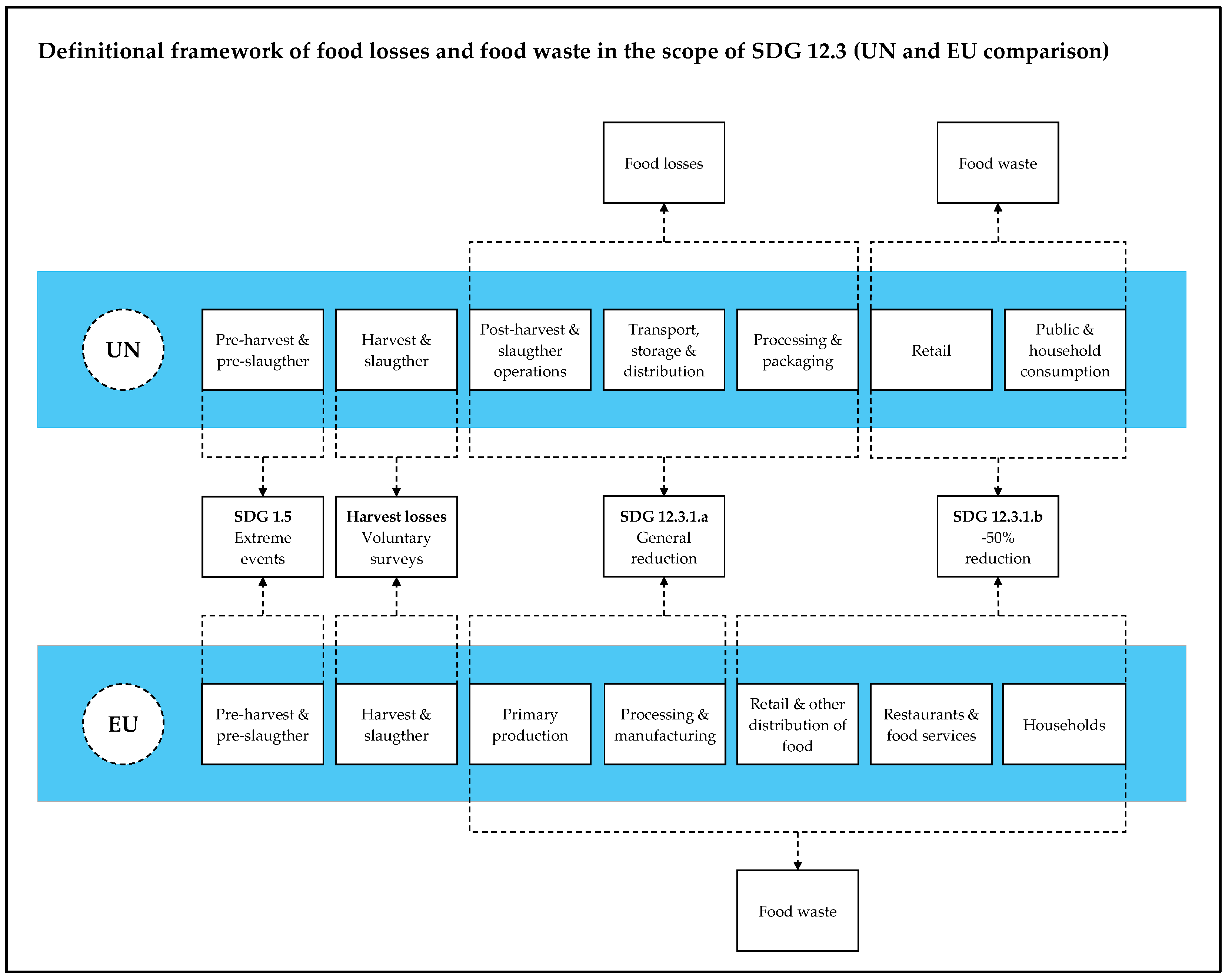
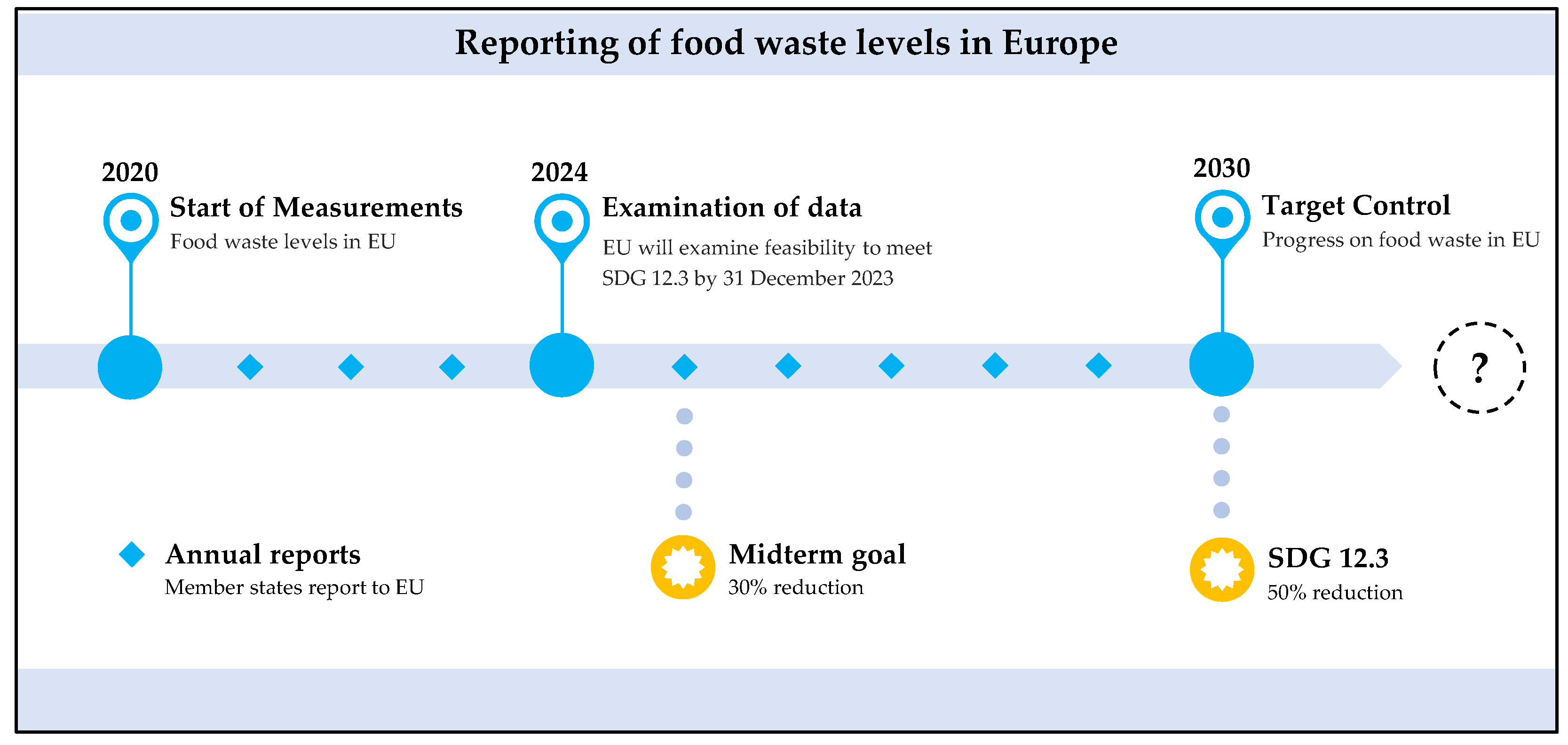
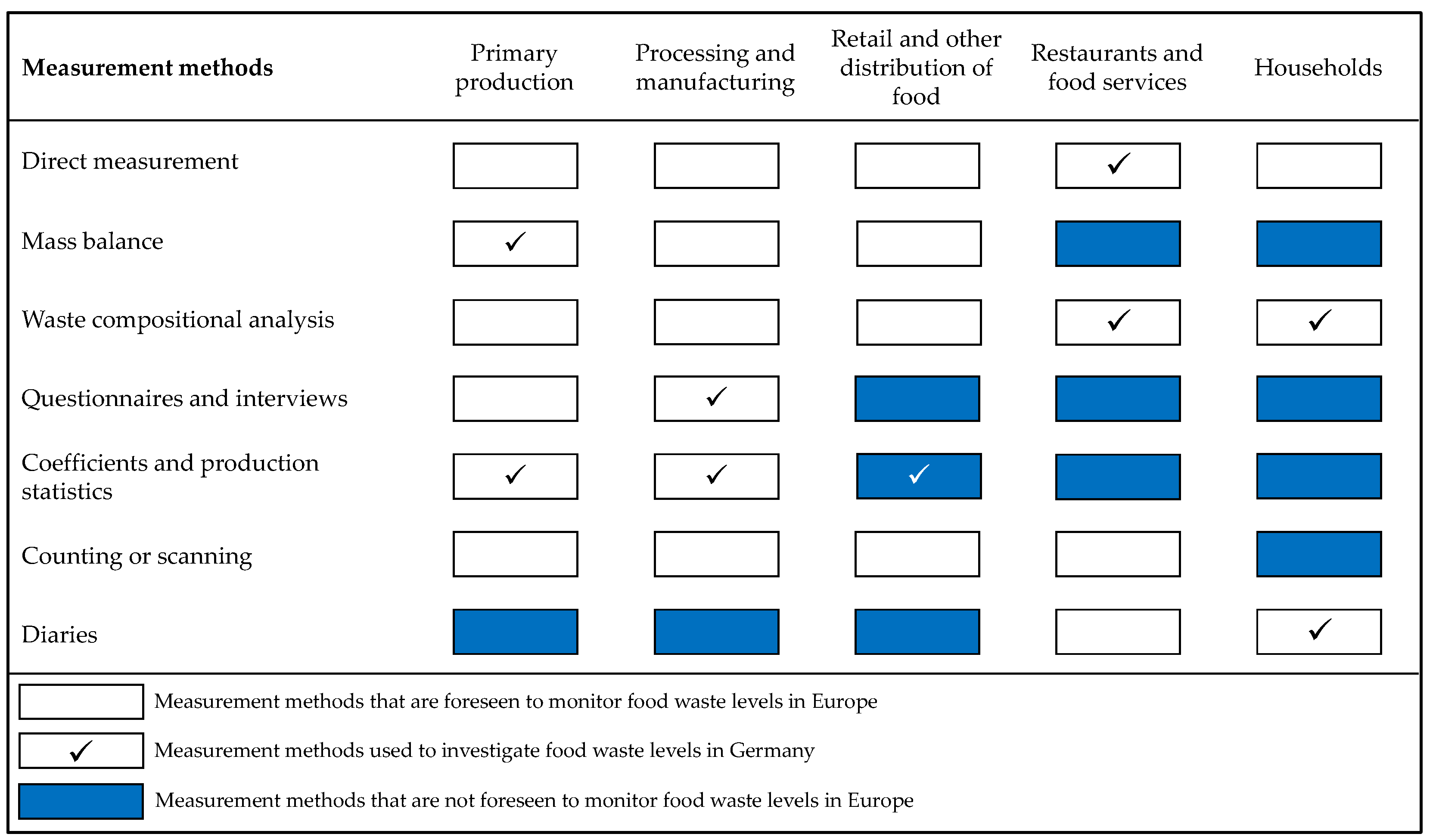
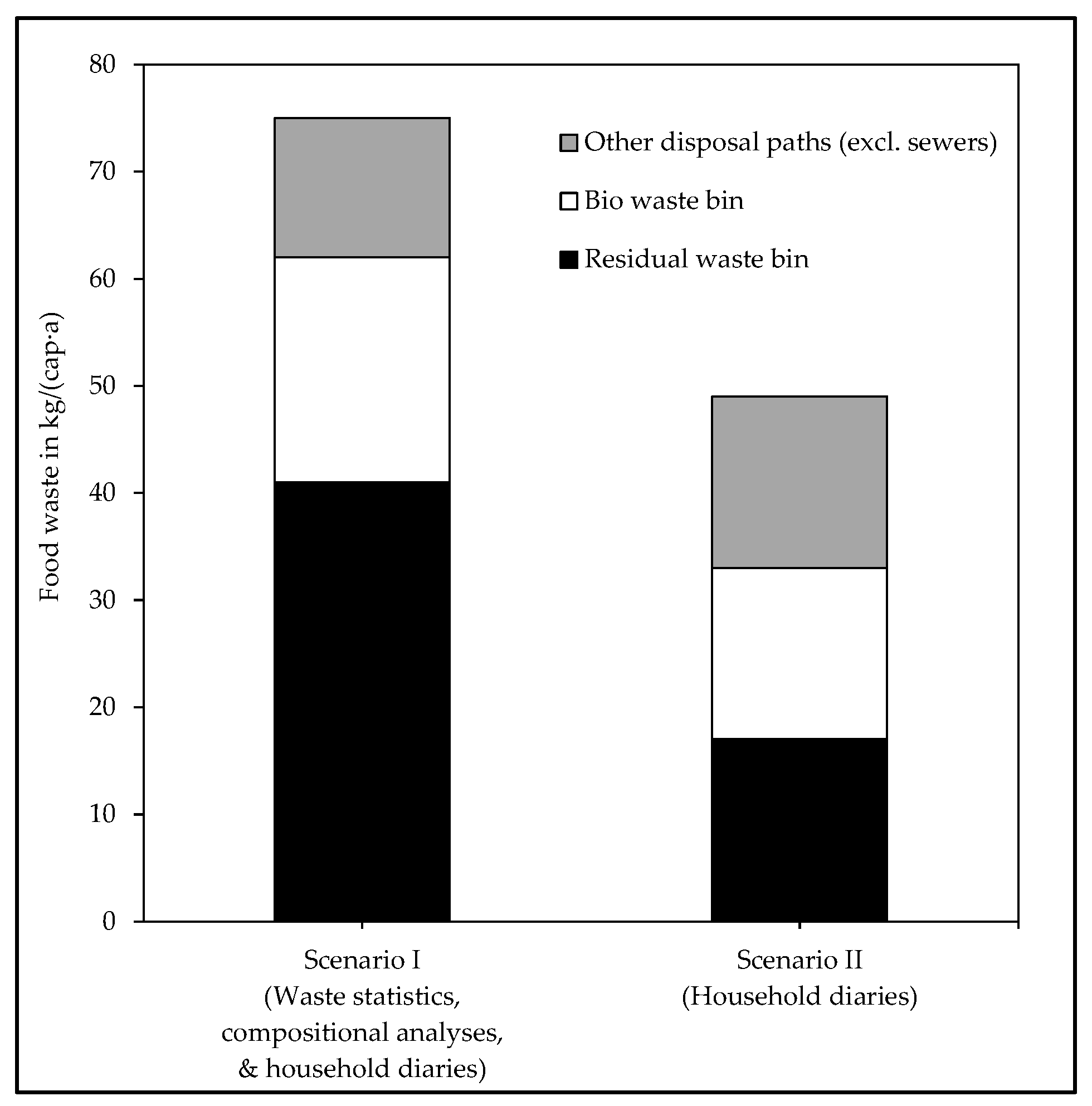
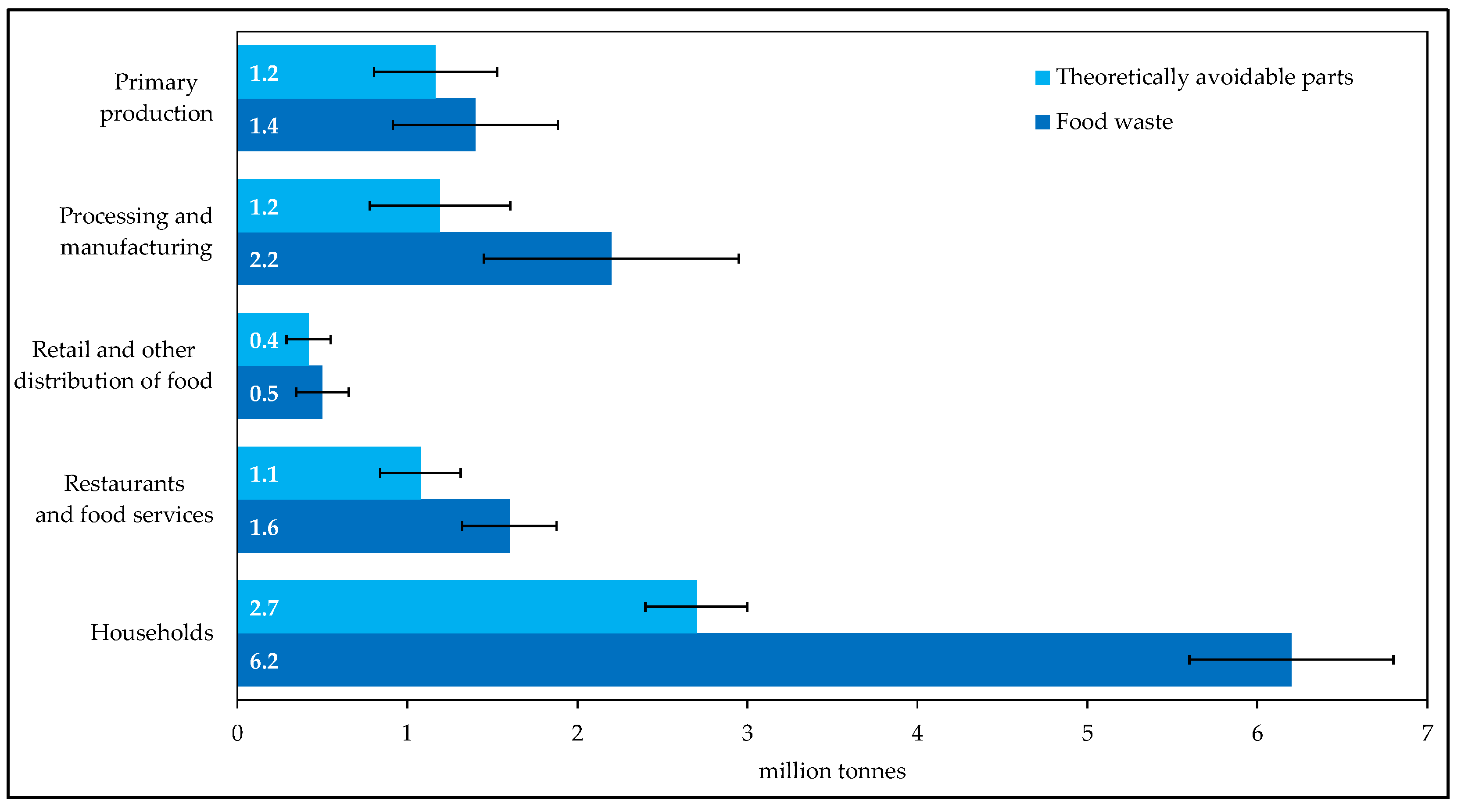
| Sector | Food Groups | Food Waste | Avoidable Parts |
|---|---|---|---|
| Primary production | Cereals | 202 ± 64 | 202 ± 64 |
| Potatoes | 243 ± 85 | 174 ± 25 | |
| Sugar (from sugar beets) | 140 ± 84 | 140 ± 84 | |
| Oilseeds | 2 ± 1 | 1 ± 0.3 | |
| Pulses | 0.1 ± 0.04 | 0.07 ± 0.02 | |
| Fruit | 113 ± 33 | 100 ± 29 | |
| Vegetables | 177 ± 31 | 133 ± 53 | |
| Meat | 185 ± 85 | 150 ± 25 | |
| Fish | 61 ± 28 | 32 ± 6 | |
| Milk (dairy products) | 196 ± 67 | 196 ± 67 | |
| Eggs | 43 ± 7 | 37 ± 9 | |
| ∑ Food waste in primary production | 1360 ± 485 | 1165 ± 362 | |
| Manufactured products (NACE Code) | |||
| Supply chains (processing and manufacturing) | Meat and meat products (10.1) | 32 ± 29 | 18 ± 16 |
| Fish, crustaceans and mollusks (10.2) | 16 ± 7 | 9 ± 4 | |
| Fruit and vegetables (10.3) | 128 ± 59 | 70 ± 32 | |
| Vegetable and animal oils and fats (10.4) | 5 ± 4 | 3 ± 2 | |
| Dairy products (10.5) | 219 ± 114 | 120 ± 63 | |
| Grain mill products and starch products (10.6) | 9 ± 7 | 5 ± 4 | |
| Bakery and farinaceous products (10.7) | 687 ± 135 | 378 ± 74 | |
| Other food products (10.8) | 205 ± 80 | 113 ± 44 | |
| Beverages (11.0) | 865 ± 315 | 476 ± 173 | |
| ∑ Food waste in processing and manufacturing | 2166 ± 750 | 1191 ± 413 | |
| ∑ Food waste in production and supply chains | 3526 ± 1235 | 2356 ± 775 | |
| SDG 12.3 and EU target | General reduction | ||
| Sector | Market | Food Waste | Avoidable Parts | |
|---|---|---|---|---|
| Retail and other distribution of food | Retail | 434 ± 134 | 365 ± 113 | |
| Wholesale market | 65 ± 22 | 54 ± 18 | ||
| ∑ Food waste in retail and wholesale market (excl. food donations) | 499 ± 155 | 419 ± 130 | ||
| SDG 12.3 and EU target (−50% by 2030) | ≈250 (−50%) | ≈210 (−50%) | ||
| Facilities | ||||
| Restaurants and food services | Full-service restaurants | 414 ± 67 | 213 ± 43 | |
| Event gastronomy | 282 ± 46 | 145 ± 29 | ||
| Fast-food restaurants | 145 ± 26 | 104 ± 21 | ||
| Accommodation sector | 80 ± 21 | 58 ± 11 | ||
| Hospitals | 64 ± 11 | 52 ± 11 | ||
| Schools | 49 ± 6 | 38 ± 9 | ||
| Childcare facilities | 68 ± 8 | 53 ± 12 | ||
| Colleges and universities | 74 ± 12 | 51 ± 10 | ||
| Care institutions | 134 ± 22 | 108 ± 22 | ||
| Business canteens | 298 ± 54 | 242 ± 66 | ||
| German Armed Forces | 8 ± 1 | 4 ± 1 | ||
| Prisons | 18 ± 3 | 9 ± 2 | ||
| ∑ Food waste in restaurants and food services | 1634 ± 277 | 1077 ± 237 | ||
| SDG 12.3 and EU target (−50% by 2030) | ≈817 (−50%) | ≈539 (−50%) | ||
| Disposal paths | ||||
| Households | Municipal waste collection | Residual waste bin | 3336 ± 304 | 1468 ± 134 |
| Biowaste bin | 1742 ± 156 | 767 ± 69 | ||
| Other disposal paths | Home composting | 633 ± 58 | 278 ± 25 | |
| Pet feeding | 353 ± 99 | 155 ± 43 | ||
| Sewers | 789 ± 271 | 347 ± 119 | ||
| Others | 115 ± 17 | 51 ± 51 | ||
| ∑ Food waste in households (excluding sewers) | 6179 ± 634 | 2719 ± 322 | ||
| SDG 12.3 and EU target (−50% by 2030) | ≈3090 (−50%) | ≈1360 (−50%) | ||
| ∑ Food waste at the German retail (including other distribution of food) and consumer levels in 2015 | 8312 ± 1066 | 4215 ± 689 | ||
| SDG 12.3 and EU target (−50% by 2030) | ≈4156 (−50%) | ≈2108 (−50%) | ||
| Food Waste | Theoretically Avoidable Parts | |||||
|---|---|---|---|---|---|---|
| Mio. t | kg/(cap·year) | Share | Mio. t | kg/(cap·year) | Share | |
| Primary production | 1.4 ± 0.5 | 16.6 ± 6.0 | ≈12% | 1.2 ± 0.4 | 14.2 ± 4.4 | ≈18% |
| Processing and manufacturing | 2.2 ± 0.8 | 26.4 ± 9.1 | ≈18% | 1.2 ± 0.4 | 14.5 ± 5.0 | ≈18% |
| Retail and other distribution of food * | 0.5 ± 0.2 | 6.1 ± 1.9 | ≈4% | 0.4 ± 0.1 | 5.1 ± 1.6 | ≈6% |
| Restaurants and food services | 1.6 ± 0.3 | 19.9 ± 3.4 | ≈14% | 1.1 ± 0.2 | 13.1 ± 2.9 | ≈17% |
| Households (excluding sewers) | 6.2 ± 0.6 | 75.2 ± 7.7 | ≈52% | 2.7 ± 0.3 | 33.1 ± 3.9 | ≈41% |
| ∑ Food waste in Germany | 11.9 ± 2.4 | 144.2 ± 28.1 | 100% | 6.6 ± 1.4 | 80.0 ± 17.8 | 100% |
Publisher’s Note: MDPI stays neutral with regard to jurisdictional claims in published maps and institutional affiliations. |
© 2021 by the authors. Licensee MDPI, Basel, Switzerland. This article is an open access article distributed under the terms and conditions of the Creative Commons Attribution (CC BY) license (https://creativecommons.org/licenses/by/4.0/).
Share and Cite
Leverenz, D.; Schneider, F.; Schmidt, T.; Hafner, G.; Nevárez, Z.; Kranert, M. Food Waste Generation in Germany in the Scope of European Legal Requirements for Monitoring and Reporting. Sustainability 2021, 13, 6616. https://doi.org/10.3390/su13126616
Leverenz D, Schneider F, Schmidt T, Hafner G, Nevárez Z, Kranert M. Food Waste Generation in Germany in the Scope of European Legal Requirements for Monitoring and Reporting. Sustainability. 2021; 13(12):6616. https://doi.org/10.3390/su13126616
Chicago/Turabian StyleLeverenz, Dominik, Felicitas Schneider, Thomas Schmidt, Gerold Hafner, Zuemmy Nevárez, and Martin Kranert. 2021. "Food Waste Generation in Germany in the Scope of European Legal Requirements for Monitoring and Reporting" Sustainability 13, no. 12: 6616. https://doi.org/10.3390/su13126616
APA StyleLeverenz, D., Schneider, F., Schmidt, T., Hafner, G., Nevárez, Z., & Kranert, M. (2021). Food Waste Generation in Germany in the Scope of European Legal Requirements for Monitoring and Reporting. Sustainability, 13(12), 6616. https://doi.org/10.3390/su13126616






